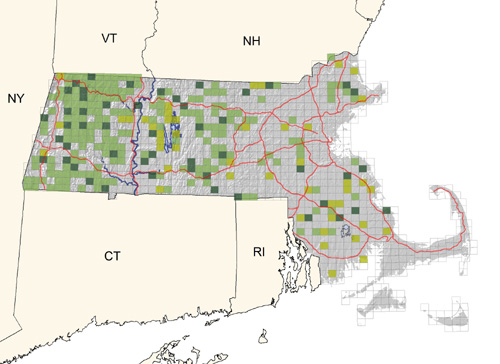Find a Bird - BBA1
Breeding Bird Atlas 1 Species Accounts
Canada Warbler
Wilsonia canadensis
Egg Dates
May 20 to June 26
Number of Broods
one

The Canada Warbler is a fairly common summer resident in Massachusetts where there are open, damp, swampy areas within extensive tracts of mixed evergreen and deciduous woods. There it is partial to the lower story of the forest and the undergrowth. Most of the suitable breeding habitat is in the Berkshires and northern and western Worcester County, but there are breeding outposts around the Commonwealth east to Essex County and southeast to the Red Maple and Atlantic White Cedar swamps of Bristol and Plymouth counties. There is no evidence that its status has changed significantly since Forbush’s day, despite statements by both Bailey (1955) and Griscom and Snyder (1955) that it had increased, especially in the eastern portion of its range.
A few Canada Warblers arrive in early May, but most appear during the last half of the month. Since they have a penchant for well-leafed-out, swampy undergrowth, they conceal themselves from all but the most persistent observers. The loud song is often the only clue to the birds’ presence. Many migrants pass through to more northerly breeding grounds.
Nesting territories may be somewhat isolated and centered on a damp swale in a forest, but, in favorable areas of dense low vegetation along sluggish streams and swamps, several males may hold adjacent territories. The song is described as a short, explosive jumble of notes, frequently introduced by a single chip. When the birds are agitated, they give a sharp chick or chink call. Courtship is seldom observed, but males are known to pursue females in usual warbler fashion.
The nest typically is placed on or near the ground, often in a streamside bank, in a hummock, on a mossy stump or log, or in the exposed roots of a fallen tree. One of the few state nests recorded was in Bridgewater in “some mixed, moist woods, mostly white pines with a few oaks and other deciduous trees, near a swampy place...in plain sight at the foot of a clump of brakes (Pteridium aquilinum)” (ACB). The bulky nest was constructed of dry leaves, bark, stems, and fern fronds and was lined with fine plant materials and hair. Three to five eggs generally are laid during the first half of June. The Bridgewater nest contained three eggs on June 9 (ACB). Clutch sizes for 2 other state nests were four and five eggs, respectively (DKW). The lengths of the incubation and nestling periods are unrecorded. Both parents tend the young, which ordinarily fledge by early July. For two or three weeks, the family group remains loosely associated as the young gain independence, and they often mingle with chickadees and other warbler species. These generally retiring birds become very bold when their young are threatened, approaching and performing elaborate distraction displays. In Massachusetts, adults have been observed feeding fledglings from June 24 to July 29 (Meservey, BOEM).
Adults have a complete molt in July or early August, during which time the young attain their first winter plumage. Southbound migration begins late in July and continues during August. Most migrants have passed by the middle of September. The Canada Warbler winters in South America, primarily in Ecuador and Peru. Because it is found in these quarters nearly eight months out of the year, perhaps no species is more inaptly named than the lovely little Canada Warbler.
Map Legend and Data Summary
Atlas 1 data collected from 1975-1979


Note: fairly common in the undergrowth of moist deciduous woodlands in hill country; uncommon in Red Maple swamps eastward
P. William Smith



